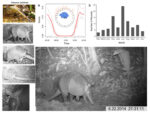Ecological aspects of Dasypus pastasae in the Colombian Altillanura, with comments on activity patterns and its identification via camera traps
Carlos A. Aya-Cuero, Federico Mosquera-Guerra, Camilo Castillo, Diego A. Esquivel, Cesar Rojano, Anderson FeijóThe Pastaza greater long-nosed armadillo (Dasypus pastasae) is a recently revalidated species and therefore poorly studied from South America. The natural history of this species is virtually unknown in the wild. Here, we describe ecological aspects of D. pastasae including activity patterns, behavioral notes, endoparasite records, and diet information retrieved from riparian forest populations in the eastern plains of Colombia. Additionally, we point out key morphological traits to differentiate D. pastasae from other congeneric armadillos present in Colombia based on camera trap records.
Aspectos ecológicos de Dasypus pastasae en la altillanura colombiana, con comentarios sobre patrones de actividad e identificación en cámaras trampa. El armadillo espuelón (Dasypus pastasae) es una especie recientemente revalidada y poco estudiada de América del Sur. La historia natural del espuelón es prácticamente desconocida y son muy escasos los datos de esta especie en vida silvestre. El presente trabajo describe diversos aspectos sobre la historia natural de esta especie, incluyendo patrones de actividad, notas sobre su comportamiento, endoparásitos, así como anotaciones sobre su dieta de poblaciones en bosques riparios de los Llanos orientales en Colombia. Además, destacamos aspectos de su morfología, útiles para diferenciar D. pastasae de otros armadillos presentes en Colombia basados en registros de cámaras trampa.
